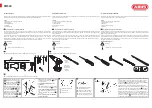
General Safe Practices
Wear approved safety glasses with side shields under your welding helmet or face shield and at all
■
times in the work area.
When working above floor level, use a safety belt to protect yourself from a fall should you get a
■
shock.
Do not install or place machine on or over combustible surfaces.
■
Be sure that all installation, operation, maintenance and repair procedures are performed only by
■
qualified persons.
Electric shock can kill.
Wear Dry, hole-free insulating gloves and body protection. Do not touch electrode with bare hand.
■
Do not wear wet or damaged gloves.
Do not touch live electrical parts.
■
Never dip the electrode in water for cooling.
■
Properly install and ground all equipment.
■
Protect yourself from electric shock by insulating yourself from work and ground.
■
Use non-flammable, dry insulating material if possible, or use dry rubber mats, dry wood or
plywood, or other dry insulating material big enough to cover your full area of contact with the
work or ground, and watch for fire.
Turn off input power using the disconnect switch at the fuse box before working on the equipment.
■
Frequently inspect input power cord for damage or bare wiring and repair or replace cord
■
immediately if damaged.
Fumes and gases can be dangerous.
Welding may produce fumes and gases hazardous to health. Avoid breathing these fumes and
■
gases. When welding, keep your head out of the fume. Use enough ventilation and/or exhaust at
the arc to keep fumes and gases away from the breathing zone.
Use enough forced ventilation or local exhaust (forced suction) at the arc to remove the fumes from
■
your breathing area.
Use a ventilating fan to remove the fumes from the breathing zone and welding area.
■
Arc rays can burn eyes and skin.
Use welding helmet with correct shade of filter to protect your eyes from sparks and the rays of the
■
arc.
Wear welders cap and safety glasses with side shields. Use ear protection when welding out of
■
position or in confined spaces. Button shirt collar.
Wear complete body protection. Wear oil-free protective clothing such as leather gloves, heavy shirt,
■
cuffless pants and high boots.






























